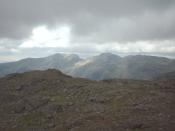The Lake District is situated in Cumbria, which is in the north, west of England and is one of many national parks in England. It also covers a massive 2,292 sq km of the north-west of England and is considered the largest national park in Britain. It is an area of glaciated mountains-including Scafell Pike, the highest mountain in England at 978 m (3,209 ft)-lying in a northern range of Ordovician slate, about 500 million years old. It consists of volcanic rock and limestone. The animal life of the Lake District includes three unique species of fish: the schelly, the vendace, and the char; and a number of golden eagles. Human settlement began in the Lake District at least 5,000 years ago, when the Pike o'Stickle and other mountains became the source of stone for axes and the sites of stone circles at Castlerigg and elsewhere. Later inhabitants dug parts of the Lake District for copper, iron-ore, graphite, and green slate.
Celts, Romans, Angles, and Vikings settled among the lakes and it was the last of these who provided such place-name elements as "-thwaite" (clearing), "fell" (mountain with grazing), "gill" (ravine), and "force" (waterfall), and introduced the local Herdwick sheep, which are born black and become white. The Lake District first became famous when a group of British poets (including William Wordsworth, Samuel Taylor Coleridge, and Robert Southey) made it their home at the beginning of the 19th centuryVisitors like to visit the Lake District National Park, as the land is conserved, especially for tourists to visit from the city. The Lake District is clean with fresh air and: - fields, mountains and not forgetting the lakes. Which are idea for people who have an interest in: photography, water sports, walking, climbing etc.
The number of visitors has...


